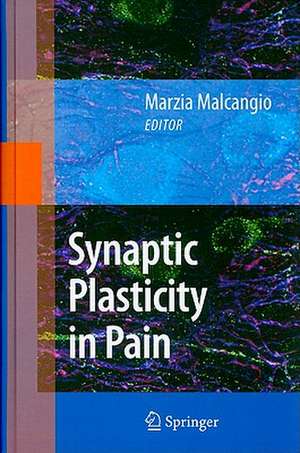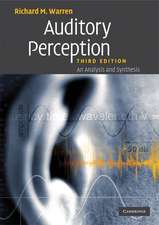Synaptic Plasticity in Pain
Editat de Marzia Malcangioen Limba Engleză Hardback – 10 iul 2009
| Toate formatele și edițiile | Preț | Express |
|---|---|---|
| Paperback (1) | 1227.36 lei 6-8 săpt. | |
| Springer – 29 noi 2014 | 1227.36 lei 6-8 săpt. | |
| Hardback (1) | 1071.83 lei 38-44 zile | |
| Springer – 10 iul 2009 | 1071.83 lei 38-44 zile |
Preț: 1071.83 lei
Preț vechi: 1410.30 lei
-24% Nou
Puncte Express: 1608
Preț estimativ în valută:
205.11€ • 212.93$ • 171.04£
205.11€ • 212.93$ • 171.04£
Carte tipărită la comandă
Livrare economică 21-27 martie
Preluare comenzi: 021 569.72.76
Specificații
ISBN-13: 9781441902252
ISBN-10: 1441902252
Pagini: 520
Ilustrații: XIV, 504 p.
Dimensiuni: 155 x 235 x 36 mm
Greutate: 1.02 kg
Ediția:2009
Editura: Springer
Colecția Springer
Locul publicării:New York, NY, United States
ISBN-10: 1441902252
Pagini: 520
Ilustrații: XIV, 504 p.
Dimensiuni: 155 x 235 x 36 mm
Greutate: 1.02 kg
Ediția:2009
Editura: Springer
Colecția Springer
Locul publicării:New York, NY, United States
Public țintă
ResearchCuprins
Anatomical Plasticity of Dorsal Horn Circuits.- Changes in NK1 and Glutamate Receptors in Pain.- Trophic Factors and Their Receptors in Pain Pathways.- Fast Synaptic Transmission in the Dorsal Horn.- Fast Inhibitory Transmission of Pain in the Spinal Cord.- Synaptic Transmission of Pain in the Developing Spinal Cord.- Slow Synaptic Transmission in the Dorsal Horn.- BDNF and TrkB Mediated Mechanisms in the Spinal Cord.- Dorsal Horn Substance P and NK1 Receptors: Study of a Model System in Spinal Nociceptive Processing.- Opioidergic Transmission in the Dorsal Horn.- CGRP in Spinal Cord Pain Mechanisms.- Amplification of Pain-Related Information.- Long-Term Potentiation in Superficial Spinal Dorsal Horn: A Pain Amplifier.- Modulation of Long-Term Potentiation of Excitatory Synaptic Transmission in the Spinal Cord Dorsal Horn.- Windup in the Spinal Cord.- Mechanisms and Targets for Chronic Pain.- Pain from the Arthritic Joint.- Spinal Mechanisms of Visceral Pain and Hyperalgesia.- Descending Modulation of Pain.- Cannabinoid Receptor Mediated Analgesia: Novel Targets for Chronic Pain States.- Spinal Dynorphin and Neuropathic Pain.- Microglia, Cytokines and Pain.- The Role of Astrocytes in the Modulation of Pain.- Spinal Cord Phospholipase A2 and Prostanoids in Pain Processing.- MAP Kinase and Cell Signaling in DRG Neurons and Spinal Microglia in Neuropathic Pain.- Microglia and Trophic Factors in Neuropathic Pain States.- The Cathepsin S/Fractalkine Pair: New Players in Spinal Cord Neuropathic Pain Mechanisms.
Recenzii
From the reviews:
“This book, based on the concept that the ‘first sensory synapse between the central terminals of primary sensory neurons and dorsal horn neurons in the spinal cord is plastic and modifiable,’ centers around the concept of pain … . intended for all individuals interested in pain research, which would include PhD students, postdoctoral scientists, and academics. … drug discovery teams in industry would also find this of interest. … the book will serve an important role in the evolution and understanding of pain medicine.” (Joseph I. Sirven, Doody’s Review Service, April, 2010)
“This book, based on the concept that the ‘first sensory synapse between the central terminals of primary sensory neurons and dorsal horn neurons in the spinal cord is plastic and modifiable,’ centers around the concept of pain … . intended for all individuals interested in pain research, which would include PhD students, postdoctoral scientists, and academics. … drug discovery teams in industry would also find this of interest. … the book will serve an important role in the evolution and understanding of pain medicine.” (Joseph I. Sirven, Doody’s Review Service, April, 2010)
Notă biografică
About the Author:
Dr. Marzia Malcangio holds a bachelors' degree in pharmaceutical chemistry and a PhD in Pharmacology from the University of Florence, Italy. She spent most of her active scientific life in London UK, establishing an internationally renowned laboratory devoted to the biology of spinal cord mechanisms underlying chronic pain. Her current work explores novel approaches for targeting neuropathic and arthritic pain unveiling, and the involvement of microglia and the mechanisms governing microglial-neuronal communication. Dr Malcangio lives in London with her husband and two sons.
Dr. Marzia Malcangio holds a bachelors' degree in pharmaceutical chemistry and a PhD in Pharmacology from the University of Florence, Italy. She spent most of her active scientific life in London UK, establishing an internationally renowned laboratory devoted to the biology of spinal cord mechanisms underlying chronic pain. Her current work explores novel approaches for targeting neuropathic and arthritic pain unveiling, and the involvement of microglia and the mechanisms governing microglial-neuronal communication. Dr Malcangio lives in London with her husband and two sons.
Textul de pe ultima copertă
Primary sensory neurons respond to peripheral stimulation by projecting to the spinal cord, where a population of neurons respond to damaging stimuli and terminate in the superficial layers of the dorsal horn. Therefore, the dorsal horns constitute the first relay site for nociceptive fibre terminals which make synaptic contacts with second-order neurons. It has recently become clear, however, that the strength of this first pain synapse is plastic and modifiable by several modulators--including neuronal and non-neuronal regulators--and studies on the fundamental processes regulating this plasticity have resulted in the identification of new targets for the treatment of chronic pain. With special emphasis on neuropathic pain, Synaptic Plasticity in Pain examines these targets and mechanisms for chronic pain in the dorsal horn, providing up-to-date research from the world's foremost pain experts. The book also delineates anatomical circuits for pain in the dorsal horn, explores the fast and slow transmissions at the pain synapse, and discusses how synaptic plasticity can be monitored in the dorsal horn during pain transmission.
Synaptic Plasticity in Pain is published at a time of intensive experimental research aimed at finding new mechanisms and targets for the treatment of chronic pain. This book will be of importance to a wide readership in the pain field including PhD students, doctoral scientists, and academics. It will also appeal to scientists who are interested in synaptic plasticity associated with other CNS functions, and to private sector drug discovery teams, who will find solid scientific support to their research in these pages.
About the Editor:
Dr. Marzia Malcangio holds a Bachelors' degree in pharmaceutical chemistry and a PhD in Pharmacology from the University of Florence, Italy. She spent most of her active scientific life in London,UK, establishing aninternationally renowned laboratory devoted to the biology of spinal cord mechanisms underlying chronic pain. Her current work explores novel approaches for targeting neuropathic and arthritic pain, and the involvement of microglia and the mechanisms governing microglial-neuronal communication. Dr. Malcangio lives in London with her husband and two sons.
Synaptic Plasticity in Pain is published at a time of intensive experimental research aimed at finding new mechanisms and targets for the treatment of chronic pain. This book will be of importance to a wide readership in the pain field including PhD students, doctoral scientists, and academics. It will also appeal to scientists who are interested in synaptic plasticity associated with other CNS functions, and to private sector drug discovery teams, who will find solid scientific support to their research in these pages.
About the Editor:
Dr. Marzia Malcangio holds a Bachelors' degree in pharmaceutical chemistry and a PhD in Pharmacology from the University of Florence, Italy. She spent most of her active scientific life in London,UK, establishing aninternationally renowned laboratory devoted to the biology of spinal cord mechanisms underlying chronic pain. Her current work explores novel approaches for targeting neuropathic and arthritic pain, and the involvement of microglia and the mechanisms governing microglial-neuronal communication. Dr. Malcangio lives in London with her husband and two sons.
Caracteristici
Focuses on emerging areas of synaptic plasticity and pain Contains contributions by leaders in the field Provides background for future drug discovery












